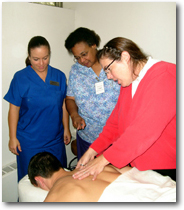Patricia Coe, DC, ND, MSACP
Instructor, Clinical Practice
ND Clinician – NUHS Whole Health Center, Lombard
 Dr. Coe completed her massage training at the Pittsburgh Center for Massage Therapy and earned her Bachelor of Science in biology at the University of Pittsburgh. Afterward, she came to National University where she earned a doctor of chiropractic degree, a doctor of naturopathic medicine degree, a Master of Science in Advanced Clinical Practice, and also finished a residency in family practice. In addition, she is certified to teach neurostructural integration.
Dr. Coe completed her massage training at the Pittsburgh Center for Massage Therapy and earned her Bachelor of Science in biology at the University of Pittsburgh. Afterward, she came to National University where she earned a doctor of chiropractic degree, a doctor of naturopathic medicine degree, a Master of Science in Advanced Clinical Practice, and also finished a residency in family practice. In addition, she is certified to teach neurostructural integration.
“Our curriculum explores different disease processes that therapists might see in their practice. It explores whether massage would be beneficial or not in certain medical conditions,” explains Dr. Coe. “We don’t just list problems, we explain systems. So, for example, instead of just giving a list of problems that go wrong with kidneys, we teach our students to think about the functions of the urinary system and how massage affects those functions. Then we talk about specific conditions.
“Our goal is not to have students simply think, ‘I’ve heard of this so I can work on it,’ or ‘I’ve never heard of it but it must be okay to work on.’ Instead, if they know there is a problem affecting a specific organ or system, they’re going to have the knowledge to be able to reason out whether massage would be appropriate for this person. For me it’s fun to teach because of the training in critical thinking,” says Dr. Coe.
 “Part of my job is to take massage interns to do ‘outcall,’ or community service events. We do many each year, including the American Cancer Society’s Relay for Life, the Chicago Marathon, health fairs in the Chicago area, and corporate events. We even do free chair massages here on campus for the graduate students during finals, which they appreciate.”
“Part of my job is to take massage interns to do ‘outcall,’ or community service events. We do many each year, including the American Cancer Society’s Relay for Life, the Chicago Marathon, health fairs in the Chicago area, and corporate events. We even do free chair massages here on campus for the graduate students during finals, which they appreciate.”
“One thing I like about our program is our human anatomy lab. Our school gives the opportunity to actually see real muscles on real bodies and the variability from body to body. If you’re studying from a book, you’re seeing pictures in a book, pictures of a muscle, that’s it. When you’re in an anatomy lab, you’re looking at several cadavers. You can see the muscles and can compare the musculature of an 80-year-old woman and a 40-year-old man.”
Dr. Coe says she knows the program is a success, because “I hear from grads all the time. Therapists call me and tell me how happy they are with their choice of school.”
